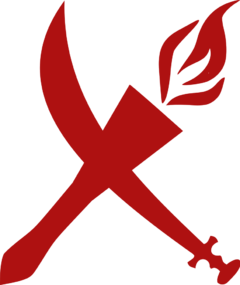Mauryism
Mauryism | |
|---|---|
 | |
| Founder | Ashok Khalatisavra Maurya |
| Founded | 1941 |
| Ideology | Councilism Bergism Nationalism Anti-imperialism |
Mauryism (Norrsk: Sorenvensk Revolusjonær Doktrine; Sorenwian Revolutionary Doctrine) is a Artadesian Councilist political ideology that has been the de facto ideology of the United Artadesian Forwards Alliance since 1919 and has been the de facto state ideology of Artadesia since 1924. It was formulated by the Premier of Artadesia Ashok Khalatisavra Maurya in his book The Program of the New Commonwealth, drawing on Bergism, Civic nationalism, and Astikite beliefs. Mauryism rejects Anarchism and Reformist socialism, believing in the necessity of a vanguard party and revolution.
Nowadays, the Mauryism followed by the UAFA and Artadesia has evolved in many ways, primarily in the rejection of much of its doctrine rooted in Astikism, and the rejection of the need for a vanguard party, leading many to dub them Neo-Mauryites. Criticisms of Mauryism are often linked to criticisms of Artadesia as a whole, and mainly focus on its nationalist tendencies, authoritarianism, and the supression of minorities done by the Artadesian government under Premier Maurya.
History
Background
Councilism was introduced to Artadesia around the 1880s, mainly through distributions of !Manifesto via the !British in Zikam. It grew in popularity among certain sections of the growing Artadesian middle class, and was one of the major influences on Dr. Sohan Jhunjhunwala's Philosophy of the Liberation of the Nation. The first Councilist party in Artadesia, the United Udesian Worker's Front was founded in 1889, and was quickly banned by !British and Imperial authorities, who deemed it dangerous, forcing it underground. In 1901, a split in the UUWF caused the Airyavej chapter to mostly leave to form the Councilist Party of Artadesia, which would quickly become the largest Councilist party in Artadesia, and Ashok Maurya would join the CPA in 1909
Artadesia in the early 20th century was in a precarious position, being under an effectively monarchical government which had become beholden to the interests of Marisian powers. Chunks of Artadesian territory, from much of the centre of Chakhadesh to the island of Kartakam off of Venikarikam were under the direct control of various foreign states and one-sided trade agreements were imposed on Artadesia via force of arms, draining its wealth. At the time, Artadesia was very agrarian, with the main industrialization in foreign-controlled areas, however the Artadesian economy and political system was not feudal, functioning off of a bureaucracy and state control of land. This meant that many Councilist politicians in Artadesia attempted to fit Councilist theories of the progression of economic systems to Artadesia, often modifying them.
Formulation
By 1916, Maurya had taken control of the CPA (which he had renamed the United Artadesian Forwards Alliance), and began a process of formulating a specific party line as well as an analysis into Artadesian economic conditions. The result of this was his book, published in 1919, The Program of the New Commonwealth, subtitled "A Treatise on the Application of Bergist Theory to the Continent of Sorenway". It details his conception of the stages of Artadesian historical development and the structure of a Councilist party that can succeed in revolution in Sorenway. It also introduces the term "Sorenway Revolutionary Theory", and is widely regarded to be the primary work of theory for Mauryism.